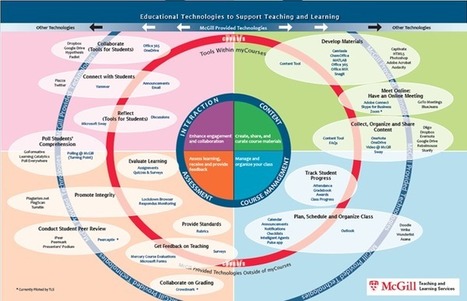Thought experiments can help shape the manner in which we proceed, the technologies we develop, and the approaches to implementation that we take. Our process — writing about an idea, developing a workshop, and facilitating a discussion with colleagues — has provided some insight into what needs to happen next for the LearningOS to become more than a theory.
1. Approach learning technologies as part of a diverse ecosystem designed to support multiple pedagogies. Institutions need to move away from thinking that one system will do everything. The reality is that if the system can't support all the teaching and learning happening at your institution, instructors and students will find somewhere else to do it. This creates fractured student experiences and situations where instructors are on their own. Conceptualizing learning technologies as an ecosystem, designed to support diversity, not singular unity, will help maintain a vision of a shared digital learning space. McGill University has used this concept of an ecosystem to help better communicate the wide array of learning technologies available to instructors. Their concept map categorizes tools into four pedagogical areas (content, course management, interaction, and assessment) and then maps it across rings of support (within the LMS, university-supported outside the LMS, and other unsupported tools outside the LMS).
2. Do better at creating and adopting standards. Standards drive innovation forward. Projects like LTI, Unizin, and Caliper need acceptance across industries to ensure that standards can be designed, changed, and adopted moving forward. Not only do companies need to be held accountable to these standards, but the bodies creating these standards need to implement them better. Standards need to support more types of data than they currently do, and standards bodies need to be agile enough to move with the market. In addition, companies need to look at adopting standards instead of preferring to rely on their own APIs.
3. Pick the right tool for the right purpose. Institutions need better analysis of learning technologies and how they can benefit learning. The Courseware in Context Framework (CWiC) is starting to do this by supporting postsecondary decision makers in effectively navigating the market of courseware solutions. An interactive version of the CWiC Framework has been embedded into the LearnPlatform, a "data-driven, peer-reviewed" index of courseware products. Using tools like LearnPlatform can help crowdsource quality. Tools can be promoted and shared not on their marketing prowess, but on their added value to teaching and learning.
4. Focus conferences on challenges, problems, and questions, not exclusively disseminating solutions. We need to critically engage with our colleagues around LearningOS and digital learning environments. Fuzzy ideas should be workshopped at pre-conference sessions and then written up and developed further.
Via Miloš Bajčetić



 Your new post is loading...
Your new post is loading...







